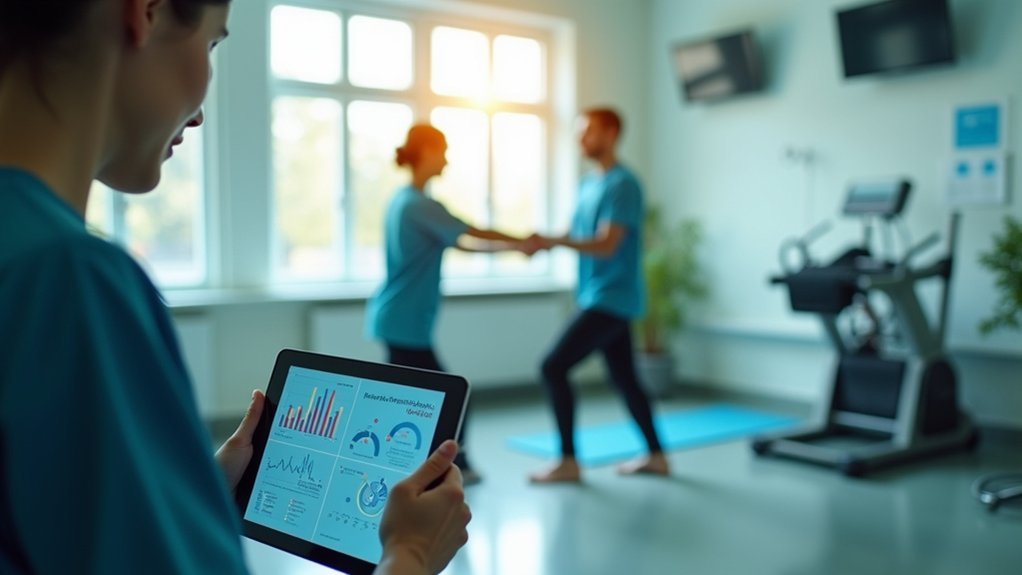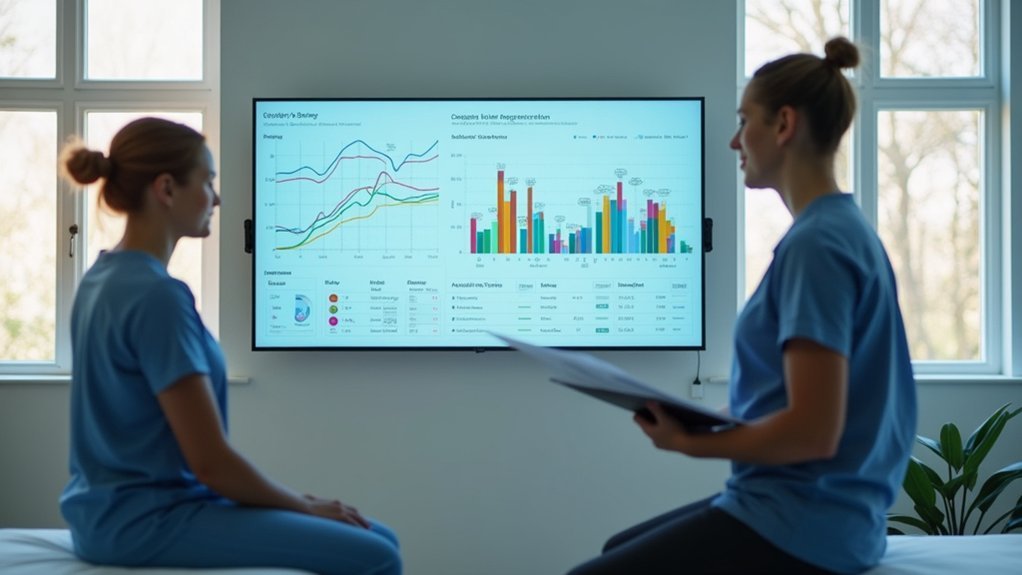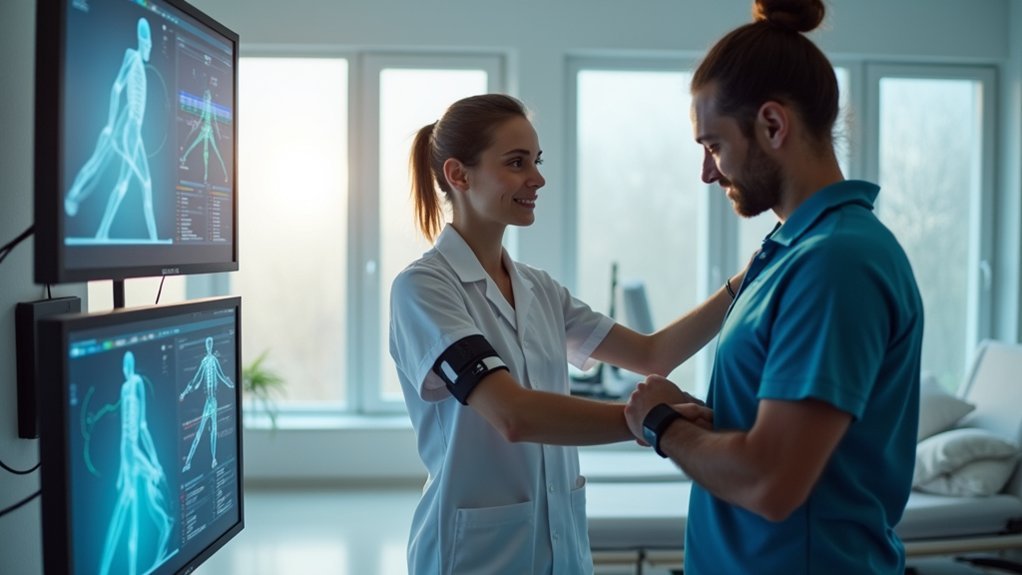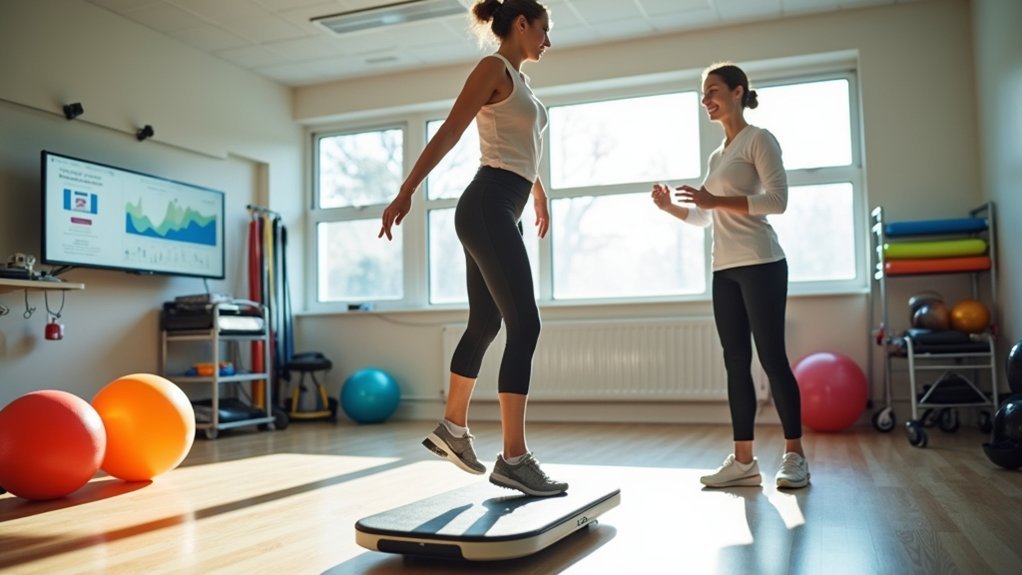Modern coordination tools have revolutionized physical rehabilitation therapy through integrated platforms that connect your entire care team. You’ll benefit from real-time communication systems, progress tracking dashboards, and AI-powered scheduling that optimizes your recovery journey. Mobile applications guarantee you can continue exercises at home while therapists monitor your progress remotely. Cross-facility networks maintain consistent care even when shifting between providers. Discover how these technological innovations can greatly improve your rehabilitation outcomes and experience.
Integrated Electronic Health Record Platforms for Seamless Care Coordination

Rehabilitation success hinges on the seamless flow of information between care providers. When you implement integrated electronic health record platforms like Raintree or PtEverywhere, you’re revealing powerful care coordination capabilities for your rehabilitation therapy team.
These systems give your practitioners real-time access to extensive patient data, enabling immediate treatment plan adjustments based on evolving needs.
Your multidisciplinary team benefits from streamlined communication while accessing unified patient histories across different specialties.
Modern EHR platforms incorporate telehealth functionalities, extending your reach to patients unable to attend in-person sessions.
The built-in data analytics track patient outcomes and progress metrics, informing more personalized rehabilitation approaches.
With interoperability features, your entire care network can seamlessly share critical information, ultimately delivering more coordinated, effective rehabilitation therapy that improves patient satisfaction.
Real-Time Communication Systems Connecting Therapists and Patients
Real-time communication systems have revolutionized rehabilitation therapy by enabling you to message your therapist instantly about challenges or progress with your treatment plan.
You’ll benefit from scheduled video check-ins where therapists can observe your technique and make immediate adjustments without requiring an in-person visit.
Customized exercise tracking alerts notify both you and your therapist when activities are completed or missed, creating a seamless accountability system that enhances your recovery journey.
Efficient Patient-Therapist Messaging
When patients and therapists communicate effectively, rehabilitation outcomes improve dramatically.
Efficient patient-therapist messaging systems transform traditional therapy by enabling real-time updates and feedback between sessions. You’ll experience increased engagement and satisfaction as you gain instant access to your treatment plans and progress tracking.
These communication tools foster a collaborative approach to your recovery journey while increasing accountability. You’re more likely to adhere to rehabilitation protocols when you can easily reach your therapist with questions or concerns.
The integration with electronic medical records (EMR) guarantees your therapist provides truly personalized care based on your complete history.
For those with mobility limitations or living remotely, these messaging platforms make rehabilitation more accessible by reducing unnecessary in-person visits while maintaining quality care.
Video Conferencing Progress Checks
Although in-person therapy sessions remain valuable, video conferencing has revolutionized rehabilitation by enabling consistent progress checks between office visits.
You’ll benefit from real-time communication with your therapist, who can immediately adjust rehabilitation plans based on your performance.
These virtual check-ins strengthen the therapist-patient relationship while boosting your accountability throughout recovery.
With platforms integrated with EMR systems like PtEverywhere, your therapist can access your complete medical history during consultations, ensuring informed guidance.
Video conferencing greatly improves access to rehabilitation services, especially if you live in remote areas.
You’ll save travel time and costs while maintaining high-quality care.
Perhaps most importantly, these regular progress checks actively involve you in your recovery journey, empowering you to take ownership of your rehabilitation goals.
Alert-Based Exercise Tracking
Alert-based exercise tracking represents the next evolution in rehabilitation technology, connecting you directly with your therapist during at-home exercises. These systems boost your accountability through timely reminders while allowing therapists to monitor your progress remotely using wearable technology.
| Feature | Benefit |
|---|---|
| Real-time communication | Immediate feedback on exercise form |
| Automatic reminders | Enhanced adherence to rehabilitation protocols |
| Wearable integration | Tracking of essential metrics and movement patterns |
| Regular virtual check-ins | Stronger therapist-patient relationship |
| Data analytics | Personalized treatment plans based on performance |
With this technology, you’ll receive instant feedback on your form while your therapist accesses valuable data to refine your rehabilitation journey. The system analyzes your performance trends, enabling targeted adjustments to your personalized treatment plan for ideal recovery.
Collaborative Treatment Planning Tools for Multidisciplinary Teams
Collaborative platforms like PtEverywhere dramatically improve your team’s ability to communicate across disciplines while monitoring patient progress in real time.
You’ll find these systems integrate seamlessly with existing EMR frameworks, allowing your entire rehabilitation team to access and update treatment protocols without information silos.
Team Communication Platforms
When multidisciplinary healthcare professionals coordinate their efforts through dedicated communication platforms, patient outcomes markedly improve.
You’ll find that team communication platforms streamline collaborative treatment planning, ensuring all providers align on patient goals and progress.
These tools enable real-time data sharing among therapists, physicians, and other healthcare professionals, allowing quick adjustments to treatment plans based on collective insights.
Your team can monitor recovery trajectories more effectively while reducing administrative burdens through integrated features like task assignments and progress tracking.
Research shows that coordinated care facilitated through these platforms can reduce hospital readmission rates by up to 20%.
Treatment Protocol Integration
Through integrated treatment protocols, rehabilitation teams can now seamlessly coordinate their diverse therapeutic approaches within a unified digital environment.
You’ll find these collaborative tools transform how multidisciplinary teams develop personalized rehabilitation plans by enabling real-time data sharing and alignment on patient care goals.
Treatment protocol integration leverages powerful analytics to identify progress trends, allowing your team to optimize interventions based on immediate feedback.
The enhanced interoperability between EMR systems reduces administrative burden while ensuring all specialists remain synchronized throughout the patient journey.
Research consistently demonstrates that this team-based approach yields superior patient outcomes.
Your rehabilitation therapy practice can expect higher adherence rates and accelerated recovery timelines when implementing these coordination tools, as they create a cohesive treatment experience that adapts to individual patient needs.
Progress Tracking Dashboards That Visualize Patient Improvements

Modern rehabilitation therapy has been transformed by progress tracking dashboards that provide visual representations of patient improvement over time. These powerful tools leverage real-time data from wearable devices to offer objective measurements of recovery metrics, including range of motion and strength gains.
You’ll find these dashboards particularly effective for patient engagement, as they allow you to demonstrate tangible results that motivate clients to adhere to their rehabilitation protocols. By customizing displays to highlight specific milestones, you’re able to create personalized treatment experiences that address individual needs.
Studies show that visual tracking considerably improves patient compliance with prescribed exercises. When patients can clearly see their progress charted over time, they’re more likely to remain committed to the recovery process, ultimately leading to better outcomes.
AI-Powered Scheduling Systems for Optimized Therapy Sequences
AI-powered scheduling systems map your patient’s predictive progression path, automatically adjusting therapy sequences as recovery evolves.
You’ll see treatment timelines optimize in real-time as the system analyzes performance data and recalibrates appointment priorities based on each patient’s recovery rate.
Predictive Patient Progression Paths
While traditional rehabilitation scheduling often follows standardized protocols, predictive patient progression paths revolutionize therapy planning by harnessing the power of artificial intelligence to create dynamic, personalized treatment sequences.
Your therapists can now leverage predictive analytics to craft rehabilitation plans tailored to individual patient needs rather than using one-size-fits-all approaches.
AI-powered scheduling analyzes historical outcomes to forecast ideal therapy sequences, increasing patient adherence by 20-30% through timely, relevant interventions.
You’ll notice improved patient satisfaction as these personalized treatment pathways accelerate recovery timelines.
The technology also helps your facility allocate resources more efficiently, reducing wait times for high-demand services while enabling therapists to manage larger caseloads without sacrificing quality.
Adaptive Treatment Timeline Optimization
Because rehabilitation milestones vary dramatically between patients, adaptive treatment timeline enhancement transforms how your clinic manages therapy sequences.
AI-powered scheduling systems analyze patient data and continuously adjust treatment plans based on real-time progress tracking, guaranteeing truly personalized care for each individual.
You’ll see immediate improvements in clinic efficiency as these systems dynamically accommodate changes in patient conditions and availability.
The predictive analytics component forecasts future needs, enhancing resource allocation and reducing wait times.
Studies confirm that facilities using these tools experience fewer cancellations and no-shows, greatly boosting patient engagement.
Integration with your existing EMR systems enables seamless communication between therapists and patients, allowing for timely adjustments based on ongoing assessments.
This adaptive approach guarantees patients receive the right interventions at the best time in their recovery journey.
Recovery Milestone Sequencing
Recovery milestone sequencing represents the next evolution in rehabilitation technology, building on the adaptive timelines that have already transformed your clinic operations.
AI-powered scheduling systems now analyze patient data to create optimized therapy sequences that precisely align with individual healing trajectories.
Your team can leverage these systems to predict the ideal timing for each rehabilitation exercise, ensuring interventions occur when patients are physiologically ready to progress.
The automated scheduling reduces your administrative burden, freeing therapists to focus on personalized approach to care.
As patients complete each milestone, the system makes real-time adjustments to therapy plans based on performance data, adapting to varying recovery rates.
This data-driven sequencing leads to improved patient outcomes by maintaining the perfect balance of challenge and achievement throughout the rehabilitation journey.
Telehealth Coordination Platforms for Remote Rehabilitation Support
As technology bridges geographical gaps, telehealth coordination platforms have revolutionized rehabilitation therapy delivery. Systems like Raintree Connect now connect you with expert care regardless of your location, making rehabilitation accessible even in underserved areas.
These platforms seamlessly integrate video conferencing with electronic medical records, giving your therapist instant access to your complete history during virtual sessions. You’ll experience more personalized care as rehabilitation professionals efficiently manage larger patient volumes while maintaining quality.
COVID-19 accelerated telehealth adoption, eliminating travel costs and time constraints while preserving treatment effectiveness. You’ll likely find yourself more engaged in your recovery through regular remote monitoring and convenient messaging features.
This continuous support empowers you throughout your rehabilitation journey, helping you maintain momentum between appointments and achieve better outcomes.
Wearable Technology Integration for Continuous Monitoring and Feedback

Wearable technology has transformed rehabilitation therapy by embedding sophisticated sensors directly into items you already wear. These devices continuously monitor your performance, tracking metrics like gait, range of motion, and muscle activity while providing real-time feedback on your progress.
Your therapist can now remotely access data from your daily activities, allowing them to monitor your adherence to rehabilitation protocols outside clinical settings. This continuous monitoring enables timely adjustments to your treatment plan based on objective data rather than periodic assessments alone.
You’ll experience more personalized care as your therapy evolves with your actual performance patterns. The integration of wearables into rehabilitation not only improves your engagement and accountability but also enhances overall recovery outcomes.
Your therapist can manage more patients efficiently while maintaining the quality of personalized care through data-driven decisions.
Patient Portal Systems That Enhance Engagement and Self-Management
Patient portal systems have become powerful allies in your rehabilitation journey, working alongside wearable technology to create a thorough care ecosystem.
These platforms empower you to manage appointments, access health information, and communicate with therapists directly, fostering greater engagement in your recovery process.
Take control of your healing journey through seamless communication with providers and instant access to your health data.
With personalized treatment plans and progress tracking features, you’ll gain ownership of your rehabilitation journey. The educational resources available help reinforce therapeutic concepts between sessions. Studies show these tools lead to improved protocol adherence and higher satisfaction rates.
The integration of telehealth capabilities guarantees continuity of care through virtual consultations, eliminating barriers to accessing therapy services.
Meanwhile, therapists analyze your portal data to identify engagement patterns and tailor interventions based on your specific needs and progress.
Data Analytics Tools for Evidence-Based Treatment Adjustments
Behind every successful rehabilitation program lies a powerful framework of data analytics that transforms raw information into actionable treatment insights.
These data analytics tools track patient progress in real-time, allowing you to identify patterns and adjust personalized treatment plans accordingly.
By leveraging large datasets, you’ll strengthen your evidence-based practices and make more informed decisions about intervention strategies.
When you monitor recovery rates closely, you can make timely adjustments that optimize patient outcomes rather than waiting for scheduled reassessments.
The benefits extend beyond clinical care—these analytics enhance operational efficiency within your facility by streamlining workflows and resource allocation.
Continuous monitoring of intervention effectiveness guarantees your therapy remains responsive to each patient’s unique needs, creating a dynamic rehabilitation experience that adapts as patients progress.
Mobile Applications for Home Exercise Program Coordination
The evolution of rehabilitation technology now extends beyond clinical settings directly into patients’ homes through specialized mobile applications.
These apps deliver personalized rehabilitation exercises with instructional videos and real-time feedback, ensuring you perform movements correctly while minimizing injury risk.
Modern rehab apps guide each movement with precision, turning your living room into a safer recovery space.
Your therapist can remotely monitor your patient compliance as you track progress through the app, allowing them to adjust treatment plans based on your performance data.
You’ll find it easier to stay committed thanks to built-in reminders and gamification elements that transform routine exercises into engaging activities.
Physical therapy practices increasingly adopt these tools because they work—patients using mobile applications report higher satisfaction and achieve better recovery outcomes compared to traditional paper-based programs.
This technology bridges the gap between clinic visits, making every home session more effective.
Cross-Facility Care Coordination Networks for Transitional Rehabilitation
When patients shift between healthcare facilities, the quality of information exchange often determines recovery success. Cross-facility care coordination networks transform this shift by connecting your healthcare providers through integrated platforms that share critical information seamlessly.
These networks enable rehabilitation specialists to access your medical history and progress in real-time, developing personalized treatment plans that evolve with your recovery journey. You’ll benefit from collaborative expertise as therapists and physicians work together across different settings to optimize your care.
Research confirms that effective transitional rehabilitation coordination greatly reduces hospital readmissions. By implementing these interconnected systems, your healthcare team can deliver more efficient services while improving patient outcomes.
The streamlined communication between facilities guarantees you receive consistent, high-quality care throughout your entire rehabilitation process.
Frequently Asked Questions
Can Physical Therapy Help With Coordination?
Yes, physical therapy can markedly improve your coordination. You’ll develop better muscle strength, balance, and proprioception through targeted exercises. You’ll notice measurable progress in your movement control within weeks of consistent practice.
What Is the Highest Paid Specialty for Physical Therapy?
You’ll find the highest paid physical therapy specialties in hospital inpatient rehabilitation, where you can earn over $100,000 annually. Management positions like clinical director also offer premium salaries between $90,000-$120,000, especially in metropolitan areas.
Which of the Following Pieces of Therapeutic Equipment Might Be Used for Physical Therapy?
You can use wearable devices, robotic exoskeletons, virtual reality systems, motion capture technology, and overhead track & harness systems in physical therapy. All these tools enhance rehabilitation outcomes and patient engagement.
What Emerging Trends or Technologies Are Shaping the Future of the Physical Therapy Assistant Profession?
You’ll see AI integration, telehealth expansion, wearable tech adoption, robotics implementation, and VR/gamification transforming physical therapy assistance. These technologies enhance treatment personalization, patient monitoring, and engagement while improving clinical outcomes.
In Summary
By embracing these coordination tools, you’re not just upgrading your practice—you’re transforming lives. You’ll see patients progress faster as barriers between specialists dissolve and communication flows seamlessly. Your therapy becomes more data-driven, personalized, and accessible. The future of physical rehabilitation isn’t just about new exercises; it’s about connecting everyone involved in the healing journey through intelligent, responsive systems.





Leave a Reply